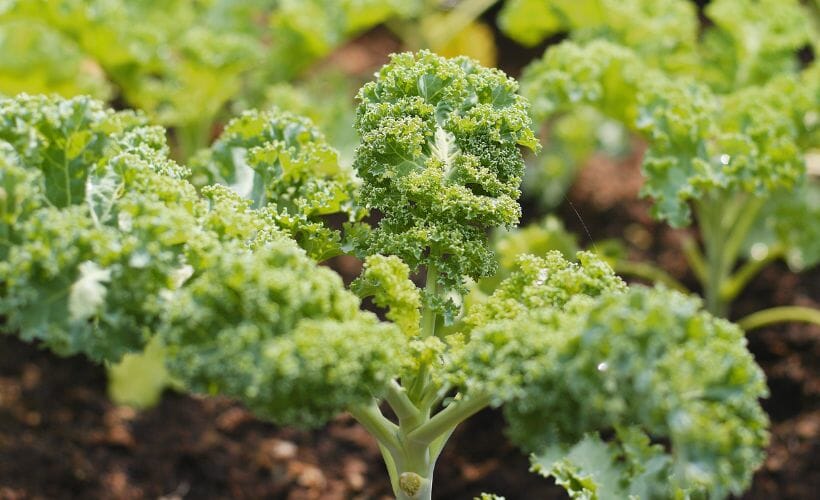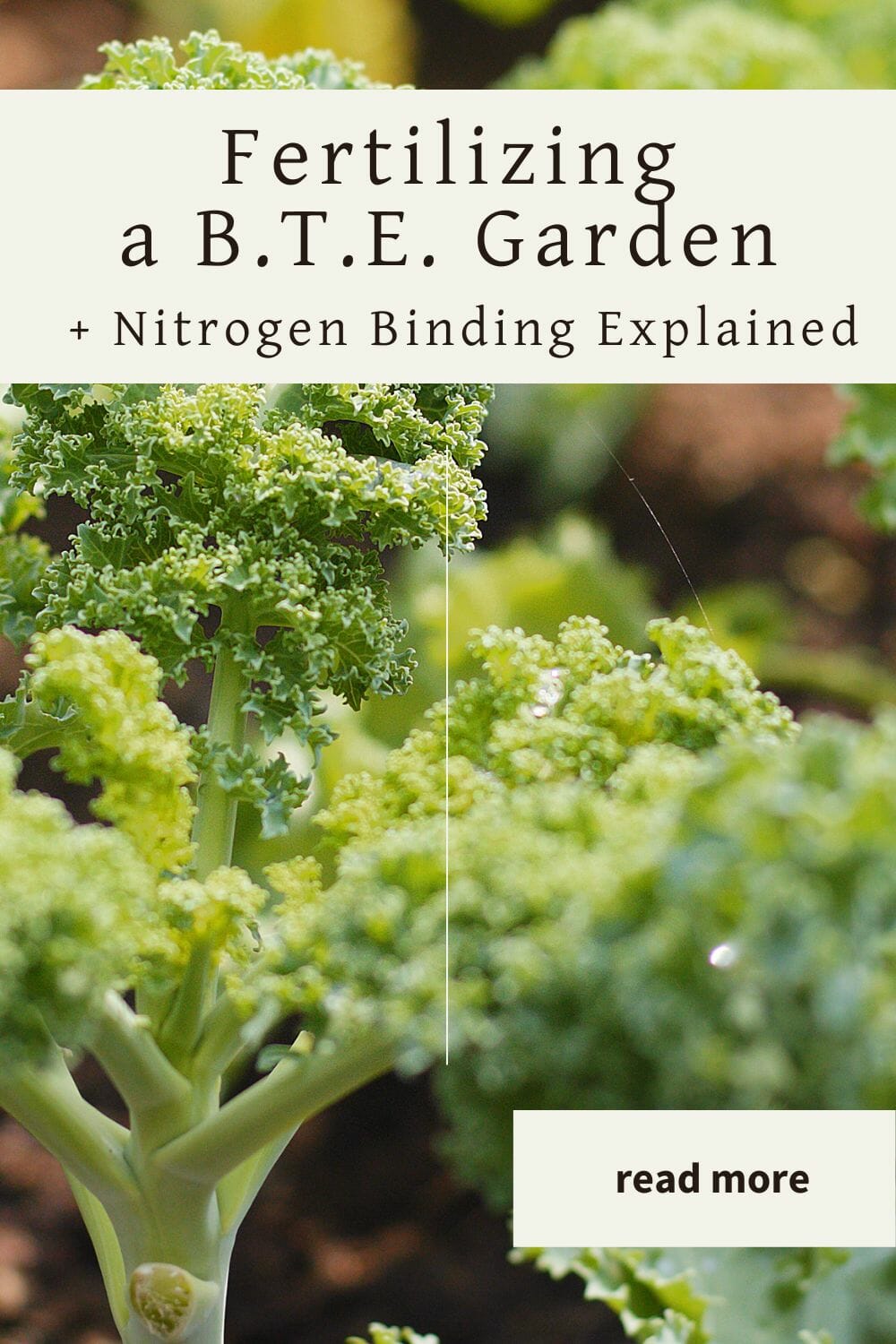Fertilizing a Back to Eden Garden + Nitrogen Binding Explained
Get the scoop on fertilizing a Back to Eden garden organically! Learn everything about nitrogen binding and the best fertilizers to use.

When I tell people about our Back to Eden vegetable garden, a no-till wood chip mulch technique made popular thanks to Paul Gautschi, one of the biggest concerns I hear is, don’t the wood chips bind up the nitrogen? I understand their concern.
When it comes to getting the best compost, the ratio of greens to browns is essential. Greens constitute the nitrogen-rich materials in the compost, while browns are the carbon-rich bits. The most successful compost piles are made of roughly equal parts of both. Here I am, dumping a bunch of browns in my garden and leaving it at that. Yikes!
But it doesn’t bind up the nitrogen, and we add fertilizers to further help our Back to Eden gardens flourish. Let me explain…
What is nitrogen binding?
Nitrogen binding occurs during part of the breakdown process of low-nitrogen organic matter. Imagine, if you will, all the teeny tiny creepy crawlies that live in your soil. These creepy crawlies feed on the low-nitrogen organic matter you’ve added to your garden. This is what causes the organic matter (be it leaves, wood mulch, cardboard, or layers of newspaper) to break down. The creepy crawlies steal nitrogen from the soil as they do this since they are not getting fresh nitrogen from the matter you’ve added. This is what binds up the nitrogen in the soil.
What’s super cool is when they are done breaking down the matter you added to the soil, they die and release ridiculous amounts of nitrogen back into the soil. More than there was before.
Nitrogen is the fuel that makes plants go. It’s used to synthesize amino acids, proteins, chlorophyll, nucleic acids, and enzymes. Plants need more nitrogen than any other element. It’s the nutrient we most often have to apply.
The good news is that nitrogen is in plentiful supply in nature; it comprises 78 percent of the earth’s atmosphere. The bad news is plants cannot extract nitrogen from the air. In fact, whether in the air or in the soil, nitrogen cannot be absorbed by plants in its elemental form. For nitrogen to be absorbed by plant roots, it must be converted, or “fixed,” into nitrates (NO3) or ammonium (NH4) ions.
That transformation occurs naturally in the nitrogen cycle. Some nitrogen is fixed in lightening strikes and delivered via rainfall. But most is converted from organic matter in the soil with the aid of microorganisms, which transform the nitrogen to nitrates.This transformation can be a slow process. But the richer the soil, the higher it is in organic matter and microorganisms, and the faster the nitrogen is made available.
Warren Schultz, Fine Gardening
Why Back to Eden doesn’t bind nitrogen…
Nitrogen binding occurs when low-nitrogen materials are incorporated into the soil. In Back to Eden, materials are never incorporated. They are merely layered on top of the soil. In the world of soil, these are two different worlds. If you recreated a Back to Eden garden in a glass, you would see all the different layers with clear lines. From bottom to top, you’d see the original soil, the improved soil, the compost, and the wood chips.
Microbes and microorganisms have different homes in different layers. Sure, a few stragglers might climb to the upper layers to help break down the wood chips, but they aren’t all going to jump ship. The majority will stay in the soil layer where the plants are rooted.
Fertilizing a Back to Eden Garden Organically
There are several ways you can fertilize your Back to Eden Garden. Some are stand-alone fertilizers, like fish emulsion, liquid seaweed, kelp meal, compost tea, and grass clippings. Others are pre-mixed fertilizers that can be purchased at big box stores.
Fish Emulsion
Fish emulsion offers a quick nitrogen “boost” for your garden. The primary ingredient is the liquid from decayed fish; let me warn you, your neighbors will know when you’ve used it. If you provide them with goodies from your garden, they might forgive the insult to their sense. I once inadvertently dumped a bottle on myself (an expensive oops), and I still smelled fishy after three showers. It’s not harmful, but I urge you to use caution during the application, or your friends may not want to spend time with you.
If you’d rather avoid the pungent smell of fish, there are several other organic options to fertilize your garden naturally.
Liquid Seaweed
Liquid seaweed doesn’t offer much of the nitrogen your soil may need, but it contains nutrients not found in other fertilizers. These are nutrients that increase the yield and nutrient uptake of your plants. Some studies currently underway suggest liquid seaweed application ten days before harvest can increase the shelf life of your produce.
Liquid seaweed can also help reduce soil acidity, which can be an issue for gardens or farms located in more acidic areas. Regularly applying liquid seaweed will improve your soil over time, and you’ll enjoy the benefits of more nutrient-dense and better-tasting produce.
Kelp Meal
I prefer liquid fertilizers, but kelp meal gives you a big bang for your buck when you apply it right where it’s needed, as opposed to watering down the whole garden with a liquid fertilizer. Like liquid seaweed, kelp is a type of seaweed that doesn’t provide large amounts of nutrients and should be used with a nitrogen-heavy fertilizer. Kelp meal includes trace elements like zinc, iron, and manganese, which are necessary for the development of healthy roots, vibrant foliage, and beautiful blooms. Plus, unlike many liquid fertilizers, kelp meal breaks down slowly, providing a steady release of nutrients that continues to feed your plants over time.
Compost Tea
I have to write something up about our compost tea setup. I’d love to take the credit for it, but my father made it for me. It’s a big food-grade bucket with a dowel through the top and a spigot from the bottom. In a lingerie bag, put a scoop of compost (or even better, those seedy weeds you are too afraid to throw in the compost bin) and zip it up. Tie it to the dowel and drape it in the barrel. Fill the barrel with water and, every day or two, give the bag a little swish in the water. You can leave it in there as long as you want, but when you are ready, use the spigot to collect the water in a pail. The water now contains nutrients from the compost and weeds.
Grass Clippings
Grass clippings are a great way to save money on fertilizer while providing a range of benefits to your Back to Eden garden. Not only are they free, but grass clippings quickly break down, greatly increasing the nitrogen of the soil and reducing evaporation. Additionally, grass clippings improve soil porosity, making it easier for plants to breathe and absorb nutrients.
Commercially Made Organic Fertilizers
There are several commercial mixes available that have the nutrients your garden needs. They include…
- Dr. Earth 9000 Nitro Big Fertilizer
- Milorganite Classic Professional 6-2-0 Fertilizer
- Feed the Plant Organic Drench
- Feed the Soil Primal Plant Food
You can find out more about organic garden amendments here.
And, of course, we always have human urine, which is the absolute best naturally occurring fertilizer for your garden.
Manure in a Back to Eden Garden
I’ve talked quite a bit about using the correct manures for the correct applications during the correct time of year, so I won’t get into that again. One caution when using manure with the Eden method is that you want to ensure the manure has begun to break down before applying it. Although this is true in any garden scenario, it’s more so in BTE.
Typically, when applying manure, it’s added to plants during transplant or at the end of the growing season. With Back to Eden, you apply manure throughout the growing season on top of the wood chips. When it rains, the nutrients from the manure trickle through the wood chips and amend the soil below. If your manure came from an animal that eats grass hay, the manure most likely contains weed seeds. Improperly “cured” manure will turn your garden into a grassy field.
Allow your manure pile to sit for six months to a year. If seeds start sprouting, cover the pile with a tarp or black plastic to prevent growth. After it has broken down, it’s safe to use for fertilizing your Back to Eden garden.
Give Love to Your Garden of Eden
The Back to Eden garden method is much like any other gardening technique. The primary thing to remember is layering the top of the soil with organic matter to provide the lower levels of the soil with nutrients instead of tilling it in. We can supplement the organic matter with a variety of organic fertilizers.
Frequently Asked Questions

Fertilizing your Back to Eden garden is important to helping your soil thrive and enabling your garden to reach its full potential. With the addition of the correct fertilizers, you can give your soil the boost it needs to help your plants grow as quickly and healthily as possible. Plus, you’ll be able to reap the benefits of a bountiful harvest season after season.
What’s your go-to fertilizer or soil amendment in your Back to Eden garden? I’d love to hear about your experiences and learn from the diverse practices of our gardening community. Share your tips, and let’s grow together!

My biggest struggle lately is figuring out how OFTEN to fertilize, and it what ratios? I thought my soil was being well fed but I did a soil test and it was totally depleted. I have a great layer of natural wood chips on my garden – how often do you recommend putting fertilizer on top? And do you only do it around plants? Or all over? Do you do it in the “off season” as well?
I typically recommend adding fertilizer on top of the wood chips once or twice a year. Early spring and late fall are good times. I apply it to the whole garden bed. If you feel like your plants are struggling, you can spot treat the struggling plants with one of the nitrogen-based fertilizers mentioned above. The fish emulsion is my favorite for that application.
I have planted comfrey to use as a fertilizer, but I have seen where people just cut it green and lay it under a plant. I would think that would burn the plant. Have you used comfrey?
you missed out a fantastic, all round, perfect for every plant, back to eden, organic, FREE fertiliser – urine!
diluted at 1:5 (1 part urine to 5 parts water – weaker if applying to baby plants) It is the perfect fertiliser.
How often would you fertilise with urine?
We do it whenever our foliage starts to yellow. If the garden is fine, we just add it to the compost pile.